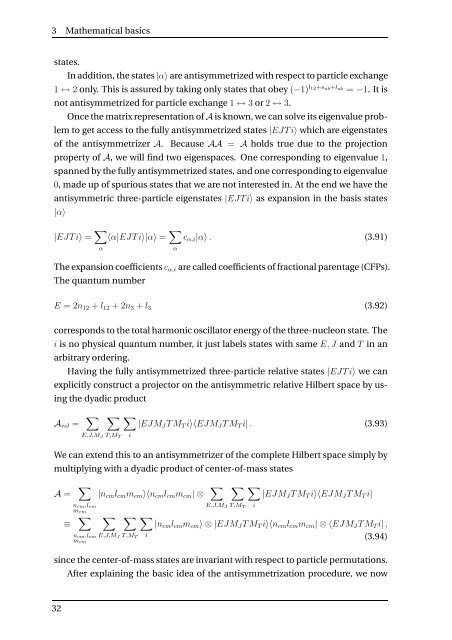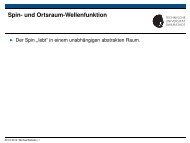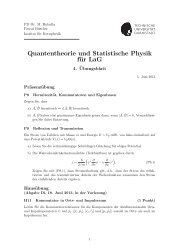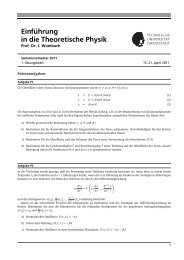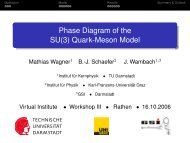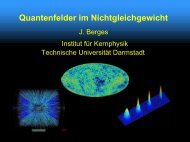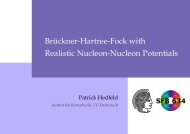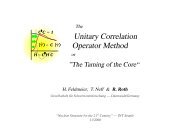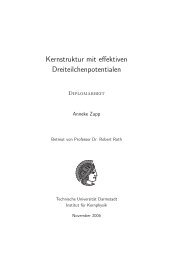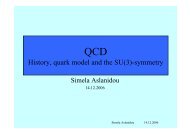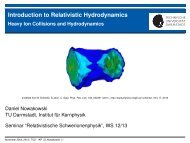Consistent chiral three-nucleon interactions in ... - Theory Center
Consistent chiral three-nucleon interactions in ... - Theory Center
Consistent chiral three-nucleon interactions in ... - Theory Center
Create successful ePaper yourself
Turn your PDF publications into a flip-book with our unique Google optimized e-Paper software.
3 Mathematical basics<br />
states.<br />
In addition, the states |α〉 are antisymmetrized with respect to particle exchange<br />
1 ↔ 2 only. This is assured by tak<strong>in</strong>g only states that obey (−1) l12+sab+tab = −1. It is<br />
not antisymmetrized for particle exchange 1 ↔ 3 or 2 ↔ 3.<br />
Once the matrix representation of A is known, we can solve its eigenvalue prob-<br />
lem to get access to the fully antisymmetrized states |EJTi〉 which are eigenstates<br />
of the antisymmetrizer A. Because AA = A holds true due to the projection<br />
property of A, we will f<strong>in</strong>d two eigenspaces. One correspond<strong>in</strong>g to eigenvalue 1,<br />
spanned by the fully antisymmetrized states, and one correspond<strong>in</strong>g to eigenvalue<br />
0, made up of spurious states that we are not <strong>in</strong>terested <strong>in</strong>. At the end we have the<br />
antisymmetric <strong>three</strong>-particle eigenstates |EJTi〉 as expansion <strong>in</strong> the basis states<br />
|α〉<br />
|EJTi〉 = <br />
〈α|EJTi〉|α〉 = <br />
cα,i|α〉 . (3.91)<br />
α<br />
α<br />
The expansion coefficients cα,i are called coefficients of fractional parentage (CFPs).<br />
The quantum number<br />
E = 2n12 + l12 + 2n3 + l3<br />
(3.92)<br />
corresponds to the total harmonic oscillator energy of the <strong>three</strong>-<strong>nucleon</strong> state. The<br />
i is no physical quantum number, it just labels states with same E, J and T <strong>in</strong> an<br />
arbitrary order<strong>in</strong>g.<br />
Hav<strong>in</strong>g the fully antisymmetrized <strong>three</strong>-particle relative states |EJTi〉 we can<br />
explicitly construct a projector on the antisymmetric relative Hilbert space by us-<br />
<strong>in</strong>g the dyadic product<br />
Arel = <br />
E,J,MJ T,MT<br />
<br />
|EJMJTMTi〉〈EJMJTMTi| . (3.93)<br />
i<br />
We can extend this to an antisymmetrizer of the complete Hilbert space simply by<br />
multiply<strong>in</strong>g with a dyadic product of center-of-mass states<br />
A = <br />
ncm,lcm<br />
mcm<br />
≡ <br />
ncm,lcm<br />
mcm<br />
|ncmlcmmcm〉〈ncmlcmmcm| ⊗ <br />
<br />
<br />
E,J,MJ T,MT<br />
i<br />
E,J,MJ T,MT<br />
<br />
|EJMJTMTi〉〈EJMJTMTi|<br />
i<br />
|ncmlcmmcm〉 ⊗ |EJMJTMTi〉〈ncmlcmmcm| ⊗ 〈EJMJTMTi| ,<br />
(3.94)<br />
s<strong>in</strong>ce the center-of-mass states are <strong>in</strong>variant with respect to particle permutations.<br />
32<br />
After expla<strong>in</strong><strong>in</strong>g the basic idea of the antisymmetrization procedure, we now


